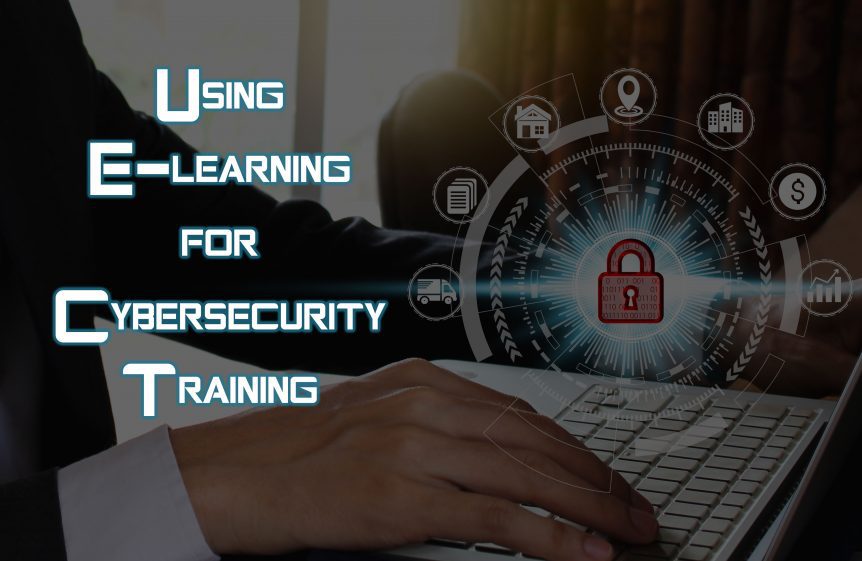Using E-learning for Cybersecurity Training
The digitisation of businesses in all sectors and industries has changed the way we all work. This has presented new challenges and new opportunities. One of the challenges is cybersecurity.
The fact is, every business is at risk of becoming a victim of a cyber-attack. This includes everything from one-person operations and micro businesses up to large businesses and international corporations.
Therefore, it is essential that all businesses take steps to reduce cybersecurity risks. This includes:
- Putting systems in place such as firewalls, virus and malicious software detection programmes, etc
- Tiering levels of access to company information to restrict that access as much as possible
- Implementing access security including two-factor authentication and biometric authentication
- Developing new security procedures on everything from keeping remote devices secure (laptops, phones, etc) to creating secure passwords
Another step that businesses should take to reduce cybersecurity risks is to implement staff training. The best way of doing this is through e-learning.
Why Is Staff Training Important?
The biggest threat that most businesses face in relation to cybersecurity is social engineering. Social engineering can take many forms, but it usually involves fraudsters, hackers, and criminals tricking someone who has access to your company’s IT systems. The person being tricked is often an employee.
According to research by the US company Verizon, 93 percent of data breaches in 2018 occurred as a result of social engineering.
In other words, your employees are a crucial line of defence when it comes to protecting your business from cybersecurity threats. Even with enterprise-level security infrastructure in place, an unwanted third-party can still gain access if a member of your team gives them a password or clicks on a link that secretly installs malicious software.
Therefore, it’s important your employees have a thorough understanding of cyber-security. This includes:
- Understanding the threats
- Being able to spot potential phishing and related attacks
- Knowing what they can do, what they should never do, and what they should check before doing
- Knowing how to keep passwords and other sensitive information secure
Benefits of Using E-Learning for Cybersecurity Training
Cybersecurity training is one of the least expensive measures your business can take to reduce your risk of becoming the victim of an attack. Using e-learning as the delivery method reduces your costs even further.
In addition, you can quickly and easily distribute e-learning training courses anywhere in the UAE or elsewhere in the world. Furthermore, all employees receive exactly the same training, removing the inconsistencies that occur when you have multiple trainers delivering classroom-based sessions.
Finally, it is easy to modularise e-learning courses which lets you quickly and cheaply update your cybersecurity training with revised or new information. You can also add new modules as new threats become known.
Tips for Using E-Learning for Cybersecurity Training
- Customise – there are plenty of off-the-shelf cybersecurity training courses you can buy. They are often less costly than a customised course, however they won’t deliver the same result or return on investment. You will get the best results and the best return on investment when the training course is customised to your business and to the everyday realities of your employees.
- Use scenarios – scenarios are a common feature of professional e-learning courses, and they are essential for cybersecurity training. Like a roleplay exercise, scenarios present the learner with a situation. The learner must then make a decision on how to deal with that situation. Again, the more relevant you can make this to the learner and they job they do, the better.
- Create timely and relevant seasonal updates – as mentioned above, delivering cybersecurity training using e-learning makes it easy for you to send training updates to employees. In addition to doing this ad hoc as the need arises, you should also send seasonal updates to match the threats that employees might face.
- Annual refreshers – as with many other areas, one of the biggest problems with cybersecurity is complacency. Immediately after employees go through training, they are at their most aware of the risks your business faces. They will also be at their most diligent in following security procedures and policies. Over time, however, standards inevitably slip as over-familiarisation sets in. An annual refresher with new information and scenarios can help to overcome this.
Adding Cybersecurity Courses to Your E-Learning Training Library
Cybersecurity courses should be one of the central elements of your e-learning training library. This gives employees a resource they can always refer back to when needed, plus you can keep tabs on who has completed each module and course. You can then use this information to assess your risks and take further steps as required.
Finally, there is no better time to invest in this e-learning training than now, not least because real threats exist today. Even the most tech-savvy employees can make mistakes with cybersecurity – e-learning will help to keep everyone focused.
